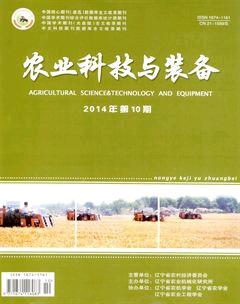α—半乳糖苷酶基因工程菌细胞破碎条件的筛选
林莉萍等
摘要:研究大肠杆菌表达的水稻α-半乳糖苷酶基因工程菌菌体破碎的条件。以菌液酶活性为指标,用超声波破碎、溶菌酶降解及菌体反复冻融3种方法破碎细胞。结果表明:超声波功率为200 W、破碎时间为1 min时测得的菌液酶的活性最大,为7.757 7
U/mL,细胞破碎效果最好;菌体反复冻融条件下测得的菌液酶活性随冻融次数的增加而增大,但样品处理时间过长;菌液酶活性随加入溶菌酶浓度增加而增加,但有处理时间长、用量大、细胞破碎不完全的缺点。
关键词:α-半乳糖苷酶;超声波破碎;溶菌酶;反复冻融
中图分类号:Q55 文献标识码:A 文章编号:1674-1161(2014)10-0037-03
α-半乳糖苷酶(α-Galactosidase, EC 3.2.1.22)属外切糖苷酶,其专一性地催化半乳聚糖中非还原末端α-半乳糖苷键的水解,并能作用于含有α-半乳糖苷的糖蛋白和糖脂质,广泛存在于植物、动物和微生物中,在食品、医药、饲料等诸多领域有广泛的应用。许多微生物来源的或用基因工程菌表达的α-半乳糖苷酶属胞内酶,需要破碎细胞壁以释放其活性。细胞壁的破碎方法很多,已有研究者用研磨、超声波、高压匀浆、酸洗玻璃珠漩涡振荡、反复冻融、酶解、煮沸等方法来破碎细胞壁提取胞内活性物质。
本研究以大肠杆菌表达的水稻α-半乳糖苷酶基因工程菌为对象,比较采用超声波破碎、溶菌酶降解及菌体反复冻融3种方法破碎菌体对酶活性释放的影响,筛选最适的破碎条件,为进一步实现酶的纯化奠定基础。
1 材料与方法
1.1 供试材料
水稻α-半乳糖苷酶基因工程菌(pET32-84411/Origami),由沈阳师范大学食品生物技术实验室提供;所用试剂购自北京鼎国昌盛生物技术有限责任公司。
1.2 仪器设备
洁净工作台,全温培养振荡器,恒温水浴槽,超声波细胞破碎机,冷冻离心机,制冰机,紫外可见分光光度计。
1.3 试验方法
1.3.1 菌体制备 将水稻α-半乳糖苷酶基因工程菌按接种量5.0%接种于LB液体培养基(含氨苄青霉素50.0 μg/mL、卡那霉素15.0 μg/mL、四环素12.5
μg/mL)中,加入0.7%的IPTG,20 ℃下诱导表达48 h,然后在4 ℃下以5 000 r/min离心15min,获得菌体沉淀。
1.3.2 α-半乳糖苷酶基因工程菌细胞破碎条件 按所获得固体菌体质量的4倍体积加入HEPES缓冲液(pH=7.0),采用以下3种方法进行菌体破碎,然后在4 ℃下以10 000 r/min离心20 min,取上清液待测。破碎方法:1) 在超声波条件下破碎细胞。将超声波功率分别设置为100 W,200 W,300 W,400 W,处理时间30~180 s。2) 在反复冻融条件下破碎细胞。将加有缓冲液的菌体放入-80 ℃的冰箱里快速冻结,之后置于冰浴溶解,冻融的次数分别为1次、3次、5次、7次、9次。3) 在加溶菌酶条件下破碎细胞。将溶菌酶按浓度1,2,3,4,5 mg/mL加入重悬菌液中,于室温下处理1,2,3,4,5 h。
1.3.3 α-半乳糖苷酶活性的测定 测定方法参照文献[1]。
2 结果与分析
2.1 超声波对菌体细胞破碎的影响
4种超声波功率不同时间下菌体细胞破碎结果如图1所示。
由图1可见:200 W超声波破碎处理下酶的活性最强;随作用时间的延长菌液的酶活性增强,破碎时间在90 s之后酶活性的增长趋于缓慢。说明破碎功率过大或过小对α-半乳糖苷酶活性都会有负效应。
2.2 反复冻融对菌体细胞破碎的影响
反复冻融条件下菌体细胞破碎结果如图2所示。
由图2可见,随着冻融次数的增加酶活性释放显著增强,5次以后趋于平缓。
2.3 溶菌酶对菌体细胞破碎的影响
溶菌酶对菌体细胞壁的作用如图3和图4所示。
由图3和图4可见:当溶菌酶的作用时间达到3 h,浓度达到2 mg/mL之后,酶活性趋于稳定。但总体而言,对α-半糖苷酶酶活性影响有限。
2.4 不同破碎条件对菌体细胞破碎影响的比较
就酶活性而言,图5对比了5种不同破碎条件对α-半糖苷酶酶活性的影响。可见,超声波功率为200 W时破碎1 min时获得菌液的酶活性是最高的,而溶菌酶处理及菌体反复冻融均没有取得理想效果。
3 结论
超声波对大肠杆菌表达的α-半乳糖苷酶菌体细胞的破碎是最为有效的,当破碎时间为1 min、功率为200 W时,α-半乳糖苷酶基因工程菌菌液酶活性最高达到7.757 7 U/mL,且操作简单,处理时间短。反复冻融和溶菌酶处理虽然也是破碎菌体细胞壁的有效方法,但对酶活性的负效应较大。
参考文献
[1] 李苏红,朱旻鹏,李拖平.重组水稻α-半乳糖苷酶的分离纯化及酶学性质研究[J].食品科学,2010,31(21):304-307.
[2] BOZENA C,ANNEKATRIN D,KARIN K.Regulation of alpha-galactosidase gene expression in primary foliage leaves of barley
(Hordeum vulgare L.) during dark-induced senescence[J].Planta,2004,218(5):886-889.
[3] CHROST B,KRUPINSKA K.Gene with homologies to known α-galactosidase are expressed during senescence of barley leaves[J].
Physiol.Plant,2000(110):111-119.
[4] BEUTLER E,KUHL W.Purification and properties of human α-galactosidase[J].Bio.Chem.,1972(247):7 195-7 200.
[5] PUCHART V,VRSANSKA M,MAHAKINGESHWARA KB,etal.Purification and characterization of α-galactosidase from a
thermophilic fungus Themomyces lanuginosus[J].Biochem.Biophys.Acta,2000(1524):27-37.
[6] 杨翠竹,李艳,阮南,等.酵母细胞破壁技术研究与应用进展[J].食品科技,2006(7):138-142.
[7] 李兰,张明霞,袁金辉.不同破壁方法对细菌产SOD活性的影响[J].食品工业科技,2008,29(10):108-111.
Abstract: The research studies the E.coli expressed rice. It studied cell disruption conditions of α-Galactosidase Gene Engineering. It used 3 methods for the examination: ultrasonic-break, lysozyme treatment, and thalli repeated freeze-thaw to disrupt cells, using liquid enzyme activity as indicator. The results showed that the optimal disruption is ultrasonic-breaking at power 200 W for 1 min and the α-galactosidase activity was yield at 7.757 7 U/mL; under the condition of thalli repeated freeze-thaw, the liquid enzyme activity increased with the number of freeze-thaw increasing, but the treatment time is too long; similarly, the α-galactosidase activity was enhanced by a rise of the lysozyme concentration and prolongation of treatment time, whereas, it was limited by longer treating time, higher lysozyme dosage and incomplete cell break.
Key words: α-galactosidase; ultrasonic-breaking; lysozyme; freeze-thawing
Physiol.Plant,2000(110):111-119.
[4] BEUTLER E,KUHL W.Purification and properties of human α-galactosidase[J].Bio.Chem.,1972(247):7 195-7 200.
[5] PUCHART V,VRSANSKA M,MAHAKINGESHWARA KB,etal.Purification and characterization of α-galactosidase from a
thermophilic fungus Themomyces lanuginosus[J].Biochem.Biophys.Acta,2000(1524):27-37.
[6] 杨翠竹,李艳,阮南,等.酵母细胞破壁技术研究与应用进展[J].食品科技,2006(7):138-142.
[7] 李兰,张明霞,袁金辉.不同破壁方法对细菌产SOD活性的影响[J].食品工业科技,2008,29(10):108-111.
Abstract: The research studies the E.coli expressed rice. It studied cell disruption conditions of α-Galactosidase Gene Engineering. It used 3 methods for the examination: ultrasonic-break, lysozyme treatment, and thalli repeated freeze-thaw to disrupt cells, using liquid enzyme activity as indicator. The results showed that the optimal disruption is ultrasonic-breaking at power 200 W for 1 min and the α-galactosidase activity was yield at 7.757 7 U/mL; under the condition of thalli repeated freeze-thaw, the liquid enzyme activity increased with the number of freeze-thaw increasing, but the treatment time is too long; similarly, the α-galactosidase activity was enhanced by a rise of the lysozyme concentration and prolongation of treatment time, whereas, it was limited by longer treating time, higher lysozyme dosage and incomplete cell break.
Key words: α-galactosidase; ultrasonic-breaking; lysozyme; freeze-thawing
Physiol.Plant,2000(110):111-119.
[4] BEUTLER E,KUHL W.Purification and properties of human α-galactosidase[J].Bio.Chem.,1972(247):7 195-7 200.
[5] PUCHART V,VRSANSKA M,MAHAKINGESHWARA KB,etal.Purification and characterization of α-galactosidase from a
thermophilic fungus Themomyces lanuginosus[J].Biochem.Biophys.Acta,2000(1524):27-37.
[6] 杨翠竹,李艳,阮南,等.酵母细胞破壁技术研究与应用进展[J].食品科技,2006(7):138-142.
[7] 李兰,张明霞,袁金辉.不同破壁方法对细菌产SOD活性的影响[J].食品工业科技,2008,29(10):108-111.
Abstract: The research studies the E.coli expressed rice. It studied cell disruption conditions of α-Galactosidase Gene Engineering. It used 3 methods for the examination: ultrasonic-break, lysozyme treatment, and thalli repeated freeze-thaw to disrupt cells, using liquid enzyme activity as indicator. The results showed that the optimal disruption is ultrasonic-breaking at power 200 W for 1 min and the α-galactosidase activity was yield at 7.757 7 U/mL; under the condition of thalli repeated freeze-thaw, the liquid enzyme activity increased with the number of freeze-thaw increasing, but the treatment time is too long; similarly, the α-galactosidase activity was enhanced by a rise of the lysozyme concentration and prolongation of treatment time, whereas, it was limited by longer treating time, higher lysozyme dosage and incomplete cell break.
Key words: α-galactosidase; ultrasonic-breaking; lysozyme; freeze-thawing

